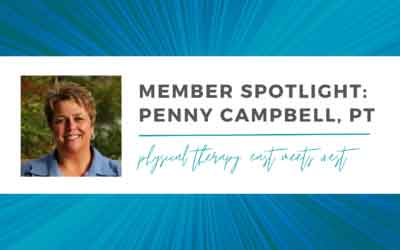In this feature, ACCWS interviews Penny Campbell to learn about her road to becoming a PT and her plans for the future in wound care. Her compassion for patients and drive to constantly improve wound care standards are admirable.
Penny Campbell is a physical therapist and a physical therapist wound care specialist. She grew up in Tennessee, graduated from East Tennessee State University with a BBA in management, then went on to complete the PT program at Tennessee State University 11 years later.

What was your inspiration to become a PT and PT wound specialist? Is there a role model you had to inspire you to lead to where you are today?
I knew I wanted to go into the medical field, as my second career but didn’t want anything to do with needles or blood. I chose Physical Therapy as a field for this reason. I had no idea how difficult it was to get into a PT program. I started volunteering to improve my chances of getting accepted and fell in love and knew this was the direction I was supposed to go.
During one of the volunteer sessions, I was to meet the therapist and was told she was doing hydrotherapy. I thought someone had a sprained ankle….getting a whirlpool treatment. Was I wrong about that….she was doing pulsed lavage to a wound. She removed the dressing and I thought I was going to pass out. I told God, “if you get me out of here without passing out I will never even as much as change a band-aid”. Funny how things work out.
My first job was in a long-term care facility. The PT there was doing a lot of electrical stimulation on our worst wounds. I knew nothing about wound care but remembered my promise about the band-aid. I hesitantly filled in for the PT when he went on vacation and that was that. I absolutely loved it and the rest is history.
I operated in somewhat of a vacuum within my facility until I started doing some case studies and consulting with BlueSky Medical, the first NPWT company to enter the market with KCI back in the early 2000s. They had a consultant on the west coast, Shelley Taylor, WOCN that was just the most amazing wound clinician I had ever met. I told her I wanted to become the east coast Shelley. She taught me so much about wound care and NPWT. I would not be where I am today without the guidance of Shelley.

What pearls of wisdom do you have to offer our young upcoming stars in wound care?
“We aren’t addressing the hole in the patient, but the whole patient”. Always remember this. Our patients are someone’s mother, father, daughter, brother. Wounds, whether a skin tear or a dehisced abdominal wound, can be life-changing or at the very least mental distractions to living a normal life. We can help change this by promoting wound healing in the fastest, most aggressive way possible to return them to some sense of normalcy. I encourage you to become a wound investigator, not a dressing changer. I always tell my patients that healing starts “between their ears”. If they believe they can heal, then they can. Choose a treatment plan that will foster timely healing as well as a functional treatment that will allow them to participate in their daily lives as much as possible.
Learn from your mistakes. All patients are different. All wounds are different. What works for one doesn’t always work for everyone. Learn from each patient you treat. Be willing to make frequent changes to the regime if needed. It will not take 30 days for you to realize a treatment isn’t working. Don’t hesitate to use modalities that you have at your disposal, such as e-stim, diathermy, ultrasound, and pulsatile lavage. You will make a difference in someone’s life, I promise.
There are many PT’s who are practicing wound care on a daily basis; reach out to them when in doubt. Subscribe to wound care journals to educate yourself. Experience and time are your best teachers. The wound care industry is actually a pretty small world and there are a lot of people who are willing to share their experiences and help guide you in the right direction. I am one of those that will help any way I can.

Q: Please comment on the regional differences across the USA in regard to PT as wound specialists and managing complex wounds, the scope of practice/limitations, are there regional differences, similarities. What direction is specialization going in wound management/care today?
I haven’t seen many differences regionally. I am, however, still surprised at the number of people who still do not know Wound Care is a PT Specialty. I am mistaken for a nurse on a daily basis, but that is an honor, as most of what I have learned about wound care has been from a nurse. I anticipate that the newly formed Wound Management Specialty within our own APTA will help change all that. This has been an undertaking that has spanned several years and taken lots of hard work from some of our Clinical Electro and Wound Management SIG members.
The depth of our presence depends greatly on the care setting. I feel our roles are different from acute care to home health to long-term care, and the outpatient setting. I am looking forward to seeing what impact the new APTA Wound Management Certification has on our roles going forward.

Briefly tell us about where you grew up, where you went to school and how the bus trip has been up to this point.
I grew up in upper northeast Tennessee, 30 minutes from both Virginia and North Carolina. My family still has our small 90 acre farm that will always be home to me. It is absolutely beautiful. The Appalachian Trail runs directly behind the farm. I graduated from East Tennessee State University in December 1985 with a BBA in Management and moved to Nashville in January 1986. I worked in the restaurant business for the next 7 years and was promoted as far as I felt a woman could go at that time.
I then started my journey toward becoming a Physical Therapist. I applied and was accepted into the PT program at Tennessee State University in Nashville, Tennessee graduating in 1996. I have only practiced in the wound care arena my entire career with the exception of the first 6 months after graduating. I have been on the bus ride of a lifetime. Every turn takes me to the next right place. There have been some flat tires and bumps along the way but it only makes the trip sweeter. I AM ON MY PATH. I am blessed and have met some wonderful people along the way. I have been at bedside, in industry, R & D, clinical sales support, and back to bedside with no end in sight.

Imagine a world where all disciplines in wound care were on the same page, had parity across all states, and budgets were not an issue. What would your utopian care setting look like?
I am helping to develop that exact utopian care setting right this moment with a group of forward-thinking people at a great company here in Tennessee. We are bringing in every aspect of care to the patient to assist in healing their wounds: wound specialists (MDs, NPs, PTs, Nurses), advanced wound care products, modalities, support surfaces, nutrition specialists, PTs, OTs, STs. We will be incorporating the patients, staff, and families to steer this “wholistic” program. I can’t wait to report back with our success stories in a follow-up interview.






